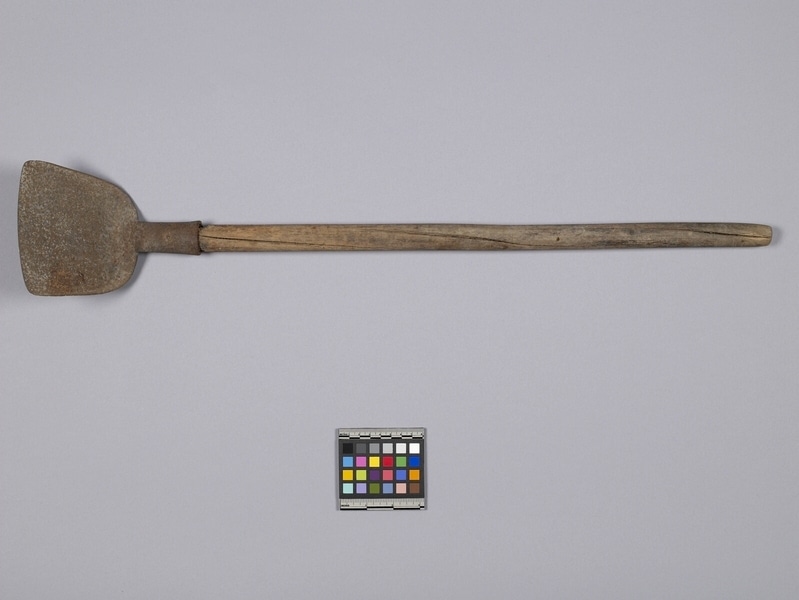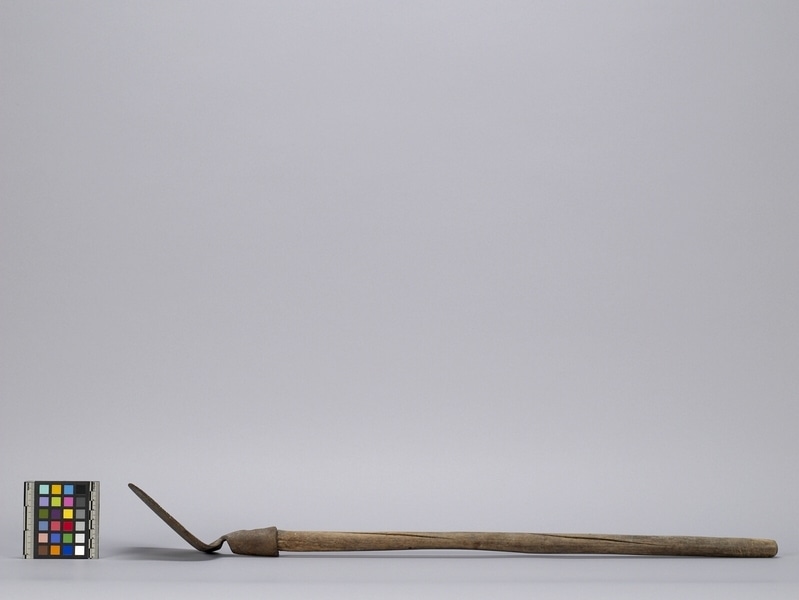Spatula Item Number: Edz1215 from the MOA: University of British Columbia


Description
Flat metal spatula attached to a straight, wooden handle.
History Of Use
Such spatulas were in common use, being employed primarily by women but occasionally by men. Rural houses had ranges for cooking made of brick or other fireproof materials, with holes in the top to accommodate the one or two large woks that were used for cooking food for people and for pigs. The spatulas were used to stir the food and rice, and to take it out of the wok. In general, women cooked day to day food, whereas men cooked special dishes for banquets. Saikung was a poor area in which people depended on the gathering of marine resources as well as farming, and in 1980 those houses that were occupied appeared to all have the traditional ranges or stoves. In the remote areas of Saikung, by the mid-twentieth century younger men often emigrated to urban areas of Hong Kong or overseas, to England or elsewhere, to try to make a living. In such cases any women left behind had to continue subsistence agriculture as well as depending on hoped-for remittances. After the mid-twentieth century the New Territories of Hong Kong began to undergo fundamental changes. The people who had been settled there before 1898, when the British colonizers claimed the area, began to give up rice agriculture and coastal fishing, turning instead to wage labour and increased employment overseas. By the end of the century, educational opportunities leading to the possibility of white-collar work also increased, together with western influences. These changes meant that objects and clothing once useful and appropriate were no longer needed and generally were discarded. Some were saved by their owners, who sometimes were willing to donate them to museums, sharing, also, their knowledge of how they were made and used.
Cultural Context
daily use
Narrative
This spatula was probably donated because it was no longer useful, being worn and rusted. Hakka people are one of the two original land-dwelling groups that settled the area that became the New Territories of Hong Kong. Their spoken language, and some customs, differed from those of the other original group, the Cantonese or Punti. The Cantonese arrived first and settled on the best rice-growing lands, while the Hakka began to arrive after the late 17th century and settled the more hilly lands.
Item History
- Made in Sai Kung, Hong Kong, China
- Collected by Elizabeth L. Johnson during 1979
- Owned by Kiu Lau Chan
- Owned by Elizabeth L. Johnson before March 17, 1980
- Received from Elizabeth L. Johnson (Seller) and Museum of Anthropology Shop Volunteers (Funding source) on March 17, 1980
What
Who
- Culture
- Chinese: Hakka
- Field Collector
- Elizabeth L. Johnson
- Previous Owner
- Kiu Lau Chan and Elizabeth L. Johnson
- Received from
- Elizabeth L. Johnson (Seller) and Museum of Anthropology Shop Volunteers (Funding source)
Where
- Holding Institution
- MOA: University of British Columbia
- Made in
- Sai Kung, Hong Kong, China
When
- Collection Date
- during 1979
- Ownership Date
- before March 17, 1980
- Acquisition Date
- on March 17, 1980
Other
- Item Classes
- metalwork
- Condition
- fair
- Accession Number
- 0610/0185